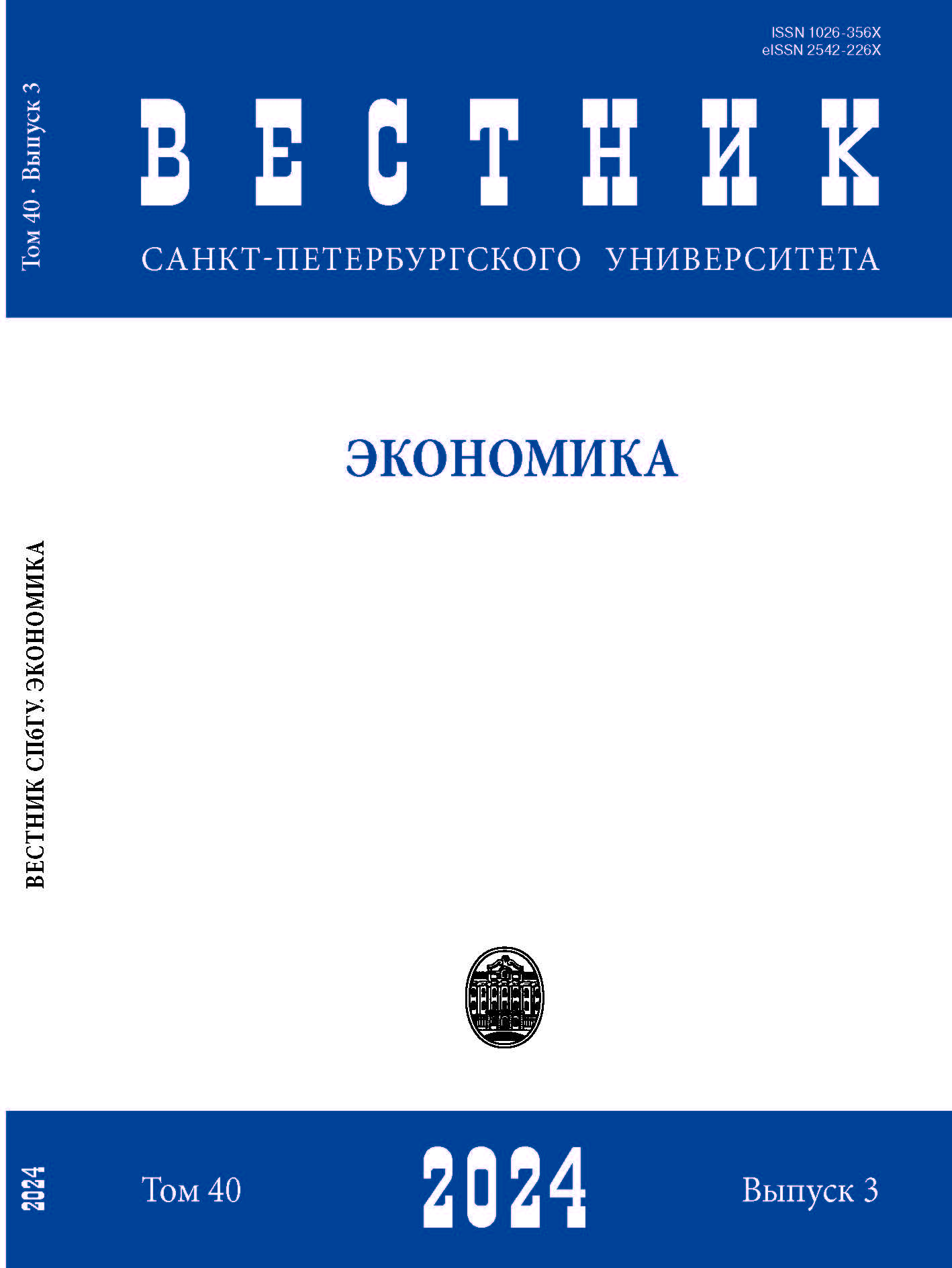Modeling the influence of social factors on the dynamics of gray wages
DOI:
https://doi.org/10.21638/spbu05.2024.306Abstract
The problem of whitewashing wages of a significant share of Russians escalated during the pandemic, post-covid recovery and, especially, against the background of geopolitical shocks. The unprecedented expansion of state support measures provided targeted and officially has
prompted entrepreneurs and citizens to get out of the shadows. Despite the obvious positive changes, the problem of salaries “in envelopes” has not eradicated itself: in modern publications, scientists return to it repeatedly. When assessing this socio-economic phenomenon,
science relies mainly on methods of regression, panel analysis, instrumental variables, etc. In this work to assess the influence of social factors on the dynamics of gray wages we used the gradient boosting method, linear modeling, random forest and a naive Bayesian classifier. As
the initial information, we used the results of the surveys of the Russian Monitoring of the Economic Situation and Health of the Population by Higher School of Economics, which are freely available. The result of the simulation is the dependence of the receiving wages method (official, “in an envelope”) on a number of factors. The organization’s industry affiliation, size, ownership, employee’s education, duration of vacation, satisfaction with professional growth
and working conditions have the strongest influence. The applied value of the results obtained is the possibility of generating control effects, both at the state level and at the level of business entities in the direction of leveling the identified reasons for receiving gray salaries and reducing the scale of the hidden wage fund.
Keywords:
salary, gray salary, gradient booster, linear models, random forest
Downloads
References
Абзалилова, Л. Р. (2021) ‘Моделирование оттока кадров в крупной компании с применением технологий интеллектуального анализа данных’, Экономика и управление: научно-практический журнал, 3 (159), с. 152–157.
Вередюк, О. В. (2020) ‘Динамика субъективного благополучия при внутрифирменной трудовой мобильности в России’, Мониторинг общественного мнения: экономические и социальные перемены, 1, с. 391–407.
Гавриленко, Ю. Е. (2022) ‘Методы устойчивой кластеризации регионов России по занятости населения’, Федерализм, T. 27, 3 (107), с. 160–177.
Гимпельсон, В. Е. (2021) Зарплата и потоки на российском рынке труда в условиях ковида. М.: Изд.дом Высшей школы экономики.
Гимпельсон, В. Е. и Капелюшников, Р. И. (2020) Российский рынок труда через призму демографии. М.: Изд. дом Высшей школы экономики.
Гимпельсон, В. Е., Капелюшников, Р. И. и Шарунина, А. В. (2018) ‘Низкооплачиваемые рабочие места на российском рынке труда: есть ли выход и куда он ведет?’, Экономический журнал ВШЭ,22 (4), с. 489–530.
Гимпельсон, В. Е., Капелюшников, Р. И., Лукьянова А., Рыжикова, З. и Куляева, Г. (2010) ‘Формы собственности в России: различия в заработной плате’, Журнал Новой экономической ассоциации, 5, с. 48–72.
Дембовский, И. А. и Машков, А. А. (2019) ‘Оценка доли серых зарплат в регионах России для агентного моделирования процессов трудоустройства жителей’, в Иванцова Е. Н., Уваров В. М. (сост.) Сборник докладов XII Междунар. науч.-практич. конф. студентов, аспирантов и молодых ученых. В 3 т. Т. 3. Старый Оскол, 2019, c. 177–181.
Журавлева, Т. Л. (2015) ‘Платит ли российское государство «справедливую» зарплату: обзор исследований’, Вопросы экономики, 11, с. 62–85.
Зарова, Е. В. и Дубравская, Э. И. (2020) ‘Метод «случайный лес» в исследовании влияния макроэкономических показателей регионального развития на уровень неформальной занятости’, Вопросы статистики, 27 (6), с. 37–55.
Ляхнова, М. В. и Рудаев, Г. С. (2021) ‘Оценка социально-экономических факторов, влияющих на желание сменить работу’, Modern Science, 3-2, с. 102–109.
Мальцева, А. В., Махныткина, О. В. и Шилкина, Н. Е. (2015) ‘Многомерные классификационные модели в сравнительном анализе социально-структурной специфики регионов России’, Науковедение, 7 (6). URL: http://naukovedenie.ru/PDF/13EVN615.pdf (дата обращения: 30.10.2023).
Хохлова, О. А., Хохлова, А. Н. и Чойжалсанова, А. Ц. (2022) ‘Разработка алгоритма анализа вакансий на рынке труда по данным из открытых источников’, Вопросы статистики, 29 (4), с. 33–41.
Шарунина, А. В. (2013) ‘Является ли российский «бюджетник» неудачником? Анализ межсекторных различий в оплате труда’, Экономический журнал ВШЭ, Т. 17, 1, с. 75–107.
Dorogush, A. V., Ershov, V. and Gulin, A. (2017) ‘CatBoost: Gradient boosting with categorical features support’, Workshop on ML Systems at NIPS 2017. URL: http://learningsys.org/nips17/assets/papers/paper_11.pdf (дата обращения: 26.06.2023).
Geanderson, E., Figueiredo, E., Veloso, A., Viggiato, M. and Ziviani, N. (2020) ‘Understanding learning software defect predictions’, Automated Software Development, 27, pp. 369–392.
Pedregosa, F., Varoquaux, G., Gramfort, A., Michel, V., Thirion, B., Grisel, O., Blondel, M., Prettenhofer, P., Weiss, R., Dubourg, V., Vanderplas, J., Passos, A., Cournapeau, D., Brucher, M., Perrot, M. and Duchesnay, E. (2011) Scikit-learn: Machine Learning in Python, JMLR, 12, pp. 2825–2830.
Prokhorenkova, L., Gusev, G., Vorobev, A., Dorogush, A. V. and Gulin, A. (2019) ‘CatBoost: Unbiased boosting with categorical features’, arXiv: 1706.09516. URL: https://arxiv.org/pdf/1706.09516.pdf (дата обращения: 20.06.2023).
Valouet, T., Al-Memar, M., Fourie, H., Bobdiwala, S., Saso, S., Pipi, M., Stalder, C., Bennett, P., Timmerman, D., Bourte, T. and De Moor, B. (2022) ‘Gradient boosted trees with individual explanations: An alternative to logistic regression for predicting viability in the first trimester of pregnancy’, Computer Methods and Programs in Biomedicine, 213, 106520.
Downloads
Published
How to Cite
Issue
Section
License
Articles of the St Petersburg University Journal of Economic Studies are open access distributed under the terms of the License Agreement with Saint Petersburg State University, which permits to the authors unrestricted distribution and self-archiving free of charge.







